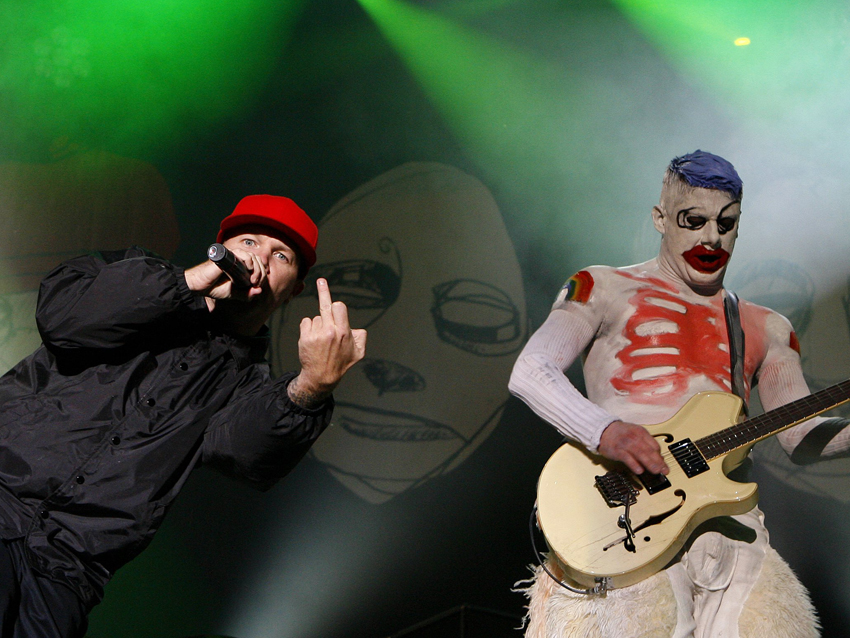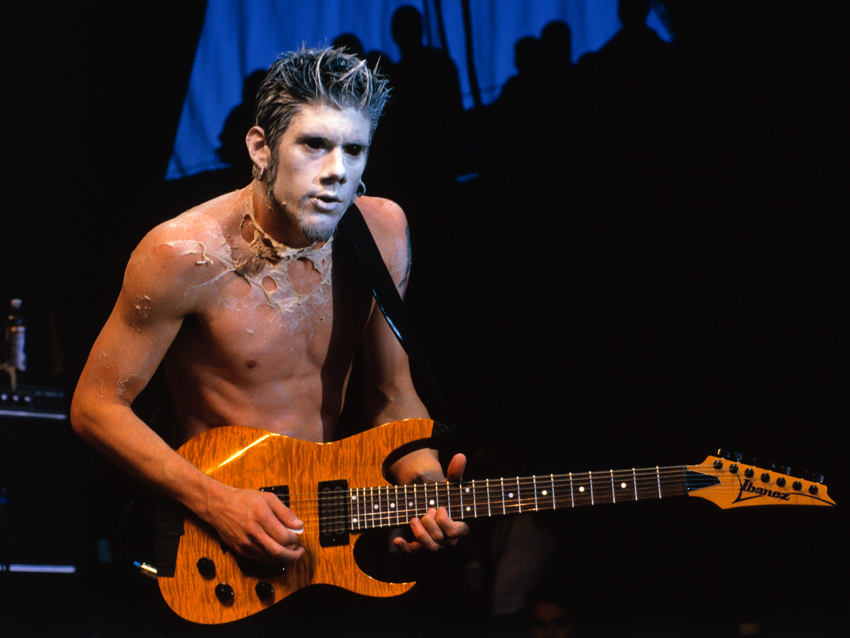

Wes Borland on stage with Limp Bizkit at the UK leg of the Sonisphere Festival, July 2011. © Fiaz Farrelly
When Wes Borland left the multi-platinum-selling rap-metal band Limp Bizkit in 2001, he was sure it was for good. And when he split again in 2005 (after rejoining a year earlier), he was more than certain that his second exit was indeed final.
Fast forward to 2011, and the 36-year-old Borland is back in the fold. This time, however, he swears he's not running away again. "I'm in Limp Bizkit to stay," he says firmly. "I've accepted the fact that Limp Bizkit is my band, one that I'm a part of, a band that I've built from the beginning. It does me no good to be in somebody else's band playing their music, like Marilyn Manson or Korn. Being in Limp Bizkit allows me to be myself."
Says the man who on any given night dresses up as anything from a gorilla to a creature from outer space. "That's part it it, too," he says, laughing. "Without me becoming different characters, I wouldn't be a real artist, and the band wouldn't be what it should be. It all goes hand in hand."
Utilizing a downtuned seven-string Ibanez guitar (which he's since abandoned) and a seemingly limitless supply of sounds that sprang from his fertile imagination, Borland virtually defined the 'nu metal' genre on big-time hits such as Nookie, Rollin' and Break Stuff. In the process, he helped guide Limp Bizkit (which also includes frontman Fred Durst, bassist Sam Rivers, drummer John Otto and DJ Lethal) to staggering success: the band's 1999 release, Significant Other, sold over 16 million copies worldwide.
"Selling records is fantastic," Borland says. "But if you're not loving what you do, and if everybody is throwing knives at you, it can get old very fast. It took me a while to come to grips with so many aspects of being in this band."
And so, the third time is apparently the charm for Borland and the Bizkit, who have just released the album Gold Cobra. A robust affair, bursting with aggressive riffs, deep grooves and a surprising amount of guitar solos, it's both a return to form that doesn't feel like a nostalgia trip and a giant leap forward that doesn't come off as a forced attempt at maturity.
Want all the hottest music and gear news, reviews, deals, features and more, direct to your inbox? Sign up here.
On a couple of cuts, Durst, famously branded by music critics as the poster boy for hooliganism of every stripe, displays an astonishing degree of introspection that shouldn't be confused with standard-issue navel-gazing.
While on tour in Brazil, Wes Borland sat down with MusicRadar to talk about Gold Cobra, his guitars and gear, and his renewed appreciation for Limp Bizkit.
The guitar seems more dominant on Gold Cobra than on previous Limp Bizkit albums. Was that the plan going into the studio, or did the role of the guitar evolve and increase as you recorded?
"I never really thought of it that way. I guess I tried to bring some of the creativity that was there on the first record… a lot of the noise and the sound generation that was somewhat impotent on the second and third records. Those records had something of a clean-cut guitar sound. I don't know... That's just how I'm playing now.
"I think it's just a result of my having worked with other people and getting better at my craft. We never talked about it as a band, 'Hey, let's make the guitar more dominant.' But if that's how it comes off, fantastico!" [laughs]
You even seem to be soloing more than ever. Shotgun, Walking Away, Loser, Killer In You all feature lead breaks.
"That's true. Solos seemed appropriate for those songs. In the past, they didn't seem all that necessary or important, but this album felt different in that way. There wasn't this big idea of 'change' per se, we just… [laughs] Yeah, I felt like playing some solos. On the other records, there were sections that you might call 'melodic leads,' but on Gold Cobra, playing real solos felt very natural. Like I said, maybe I've evolved as a guitarist, I don't know." [laughs]
Loser has so many different guitar textures - there's the echoey intro figures, crushing walls of My Bloody Valentine-like chords in the pre-chorus, zippy little lead lines throughout and a harmonized solo. How do you figure out everything you're doing on a song like that?
"For that song, Fred had made a demo at his house. It was pretty much just a synthesizer, a drum machine and his vocal, but it was really good. I loved the song right off, particularly the vocal.
"It's always a pleasure when you can compose guitar parts from a strong vocal and not just put the melody on top of guitar riffs. When you start out with just music, you're always wondering what the chorus is, what the bridge is… This way, you've got the song, and you can build your guitar parts with a lot more intent.
"With Loser, I was able to pile on a lot of elements and sounds, and I could take them away and put them back at will. It reminded me a lot of the song My Way from the Chocolate Starfish album. In fact, for the opening, I set up the exact same amp and effects chain that I used on My Way."
Which is what, exactly?
"A Maestro solid-state Echoplex and an Ibanez flanger pedal that has a setting called 'whacked.' I put that through a 1965 Zodiac Twin 30, which is a pretty bizarre old amp with push buttons for EQs. I've used that amp for a lot of clean sounds over the years.
"For the actual guitar, on that song I believe I used my signature model Yamaha set to the bridge position pickup. On Chocolate Starfish, I think I played a PRS set to the bridge position, as well - it's something of a similar sound, the two guitars."
Walking Away is a pretty poignant song - not what Limp Bizkit is typically known for. How do you see Fred growing as a lyricist?
"I think that he's getting better. We definitely have the element of party-slash-braggadocious sentiments that's inherent in rock, metal and hip-hop. The Beasties had it, Public Enemy had it, although they had a political bent to a lot of what they did… But that song goes other places; it's a bit of a departure. It sort of puts more eggs in the basket of our Jane's Addiction-ish tendencies.
"Sound-wise, that's what happens when I play a Fender Bass VI, which was kind of a failure for the company in the '60s but was utilized by people like Robert Smith from The Cure in the '80s. It looks something like a Fender Jaguar, but it's got light-gauge bass strings that are tuned an octave lower than a guitar. If you tune the strings up to a standard guitar tuning, you get a round, lush, deep guitar tone that's pretty incredible."
On so many of the new songs, your guitar tone changes every 15 seconds or so. Tom Morello once told us that he made a "sound chart" so he could keep track of his effects combinations - do you do something similar?
"No, not really. I know all of my pedals really well, and I can usually hear when I'm making a mess of things. Sometimes I just pile pedals on top of each other and my cables can get rather spaghetti-ish, so I spend a fair amount of time untangling everything.
"At the same time, though, I have a good ear for what I'm doing. Once I make a sound on a record, it's not hard for me to go, 'Oh, I did it like this,' and I remember how I went about it."

Fred Durst (with his baseball cap turned forwards!) flips the bird while Borland riffs away. © A3609 Daniel Karmann/dpa/Corbis
During the past decade, you've spent more time out of Limp Bizkit than in. You've gone and come back twice. What were your reasons for leaving? And why did you keep coming back?
"When I left the first time in 2001, I was 26 and I had absolutely had it with people making fun of the band. I felt embarrassed to have my peers write off what I was doing. We were so successful and at the top of our game, yet we were this huge target for everybody's hate. I didn't know how to handle it.
"At the same time, Fred and I weren't getting along. We were at the opposite ends of we wanted to do creatively. So it felt right to leave. I needed to make a change, be in a different band, have a whole new life.
"I had no regrets about leaving. I had so much anger about so many things, about where the band had gone… I basically gave Limp Bizkit the middle finger. Our manager, Jordan Schur, who also signed the band, started calling me about two years later, just sawing away: 'Please come back. Please talk to Fred. Please talk to the guys.' It took almost two years to get me and Fred in a room together again.
"At the time, it seemed that we might possibly be on the same page, so we tried to make a record without going on tour. The whole thing was a commercial and artistic failure.
"The record that came out, The Unquestionable Truth, which was released in 2005, is not a record that I stand behind. Now we can look back at it and say there are some cool things on it, but it's not our best work. After that album, I didn't so much leave the band than we all seemed to scatter. Everybody left and went different directions."
So what changed in 2009 when you rejoined again?
"Here's what happened: Jordan again started sawing away at me, and he said we should tour first before making a record. I said no - no way. But then I found myself thinking about it in the middle of the night, and so I said to myself, 'OK, I'm going to call Fred. I'm going to go see what he's like now.'
"The next day I went to Jordan's house to have a drink with Fred, and I couldn't remember what I was mad about anymore. Everything about him and the situation felt new again. Maybe it was just the fact that we were older, I don't know. But I do know that I sat there thinking, I'm not going to hold on to any past memories. This is a clean slate.
"I felt that we were different, but I mean that in a different way. I accepted the fact that we were different, and I wasn't going to try to change him. He was just as sensitive to me in many ways, to the point of realizing that I'm good at things that he isn't and vice-versa. It's a very bizarre bubble we're in."
You made a point of saying how you left the first time because the band was ridiculed. Of course, we all know that nothing's changed in that regard - Limp Bizkit still aren't the darling of the critics.
"No, we're not. But I've accepted that. What's interesting is, because the deck is stacked against us and we're now the underdogs, I'm interested again in a weird way. Being in the band is a challenge now, whereas before, when we were at our zenith, it was like clubbing baby seals.
"People don't care about us now. Things are harder for us. For some very weird reason, that's interesting and exciting to me. I feel as though we're building something again. My return is complicated, and there's many gray areas to it."

Borland in 1999, with his now-retired seven-string Ibanez. © Tim Mosenfelder/CORBIS
On this record, you said that you used your Yamaha signature model, plus the Fender Bass VI…
"Yeah. I also used some Jackson guitars and some Telecasters. The Fender guitars were older models. I really like their sound, particularly when the pickup is switched to the neck position. They sound rowdy."
Did you use any seven-string guitars?
"No, I stopped using those in 1999 or 2000 or so. I phased those out when I got disinterested in the other string. [laughs] Since then, I've been a six string player. One thing I do use, though, is a four-string guitar that has a bass A string, and then A-D-G guitar strings.
"It's built by a guy named George Gordaninsky, who's a Lapian luthier. It's evolved over the years, but the point of it was to have two strings that were an octave apart that were right next to each other. This allows me to play single-note parts that I could never reach on a traditional guitar. I can also make up riffs that have octave changes that would be impossible otherwise. It's a very cool guitar."
You talked about going back to an old effects chain, but did you have any kind of standard array of pedals or effects on this album?
"Normally, the distortion is always through an amp, and for this record I used an Orange 200-watt Thunderverb through an Orange 4x12 cabinet. For clean sounds, I used the Zodiac Twin 30 that I mentioned before, and for delay I rely on that Maestro Echoplex. I did have another delay unit that they don't make anymore, it's called a Malekko. They have some cool pedals, but their delay is fantastic."
Artistically, do you now get all you need from Limp Bizkit, or are you still involved with other musical projects?
"Limp Bizkit is my main priority, but my side project, Black Light Burns, is still a labor of love. We have a record written, so we'll see when that comes out. When we tour, we go out in a van and trailer with me driving.
"We'll take a soundman, but that's about it. It's bare bones. Also, whenever I get a chance, I try to tour with Combichrist. I played four dates with them last year. They're really good friends of mine."
How do you push yourself as a player?
"I try to practice a lot. I like to use effects, but I try to put a ceiling on the amount. If you spend all of your time fooling around with a bunch of effects, trying to figure out how they all work, you're not really being creative.
"I do try to listen to as many new bands as I can. I'm interested in a lot of new music, and I'm always trying to bring that into my life. That's why I like playing with different musicians: I always go to different places on the guitar when I play with other people, and that allows me to bring new sounds to Limp Bizkit.
"I think that by challenging myself and always staying slightly uncomfortable is the best way to learn and grow."
Check out Wes talking about his new Jackson Guitars backstage at Sonisphere 2011 in the following video:
Joe is a freelance journalist who has, over the past few decades, interviewed hundreds of guitarists for Guitar World, Guitar Player, MusicRadar and Classic Rock. He is also a former editor of Guitar World, contributing writer for Guitar Aficionado and VP of A&R for Island Records. He’s an enthusiastic guitarist, but he’s nowhere near the likes of the people he interviews. Surprisingly, his skills are more suited to the drums. If you need a drummer for your Beatles tribute band, look him up.
